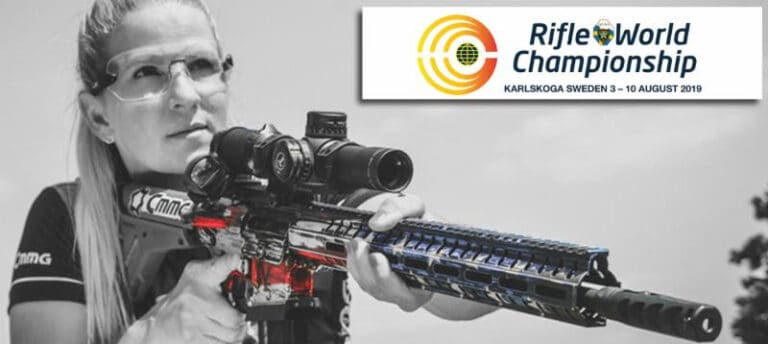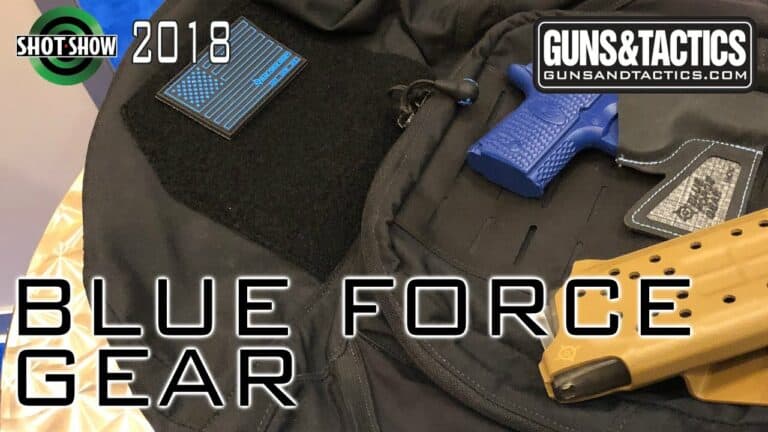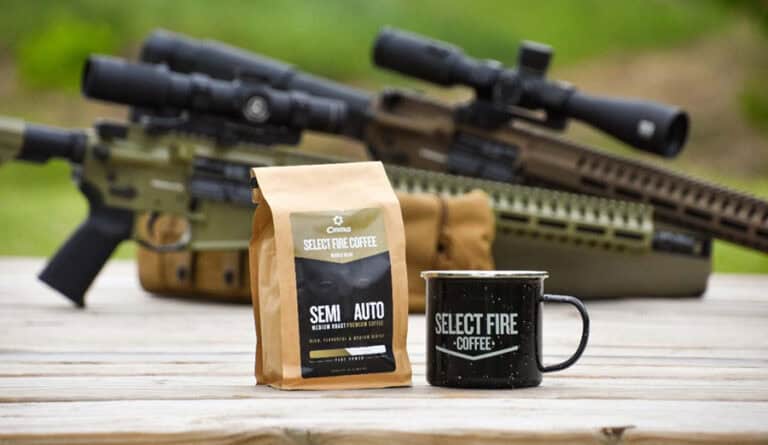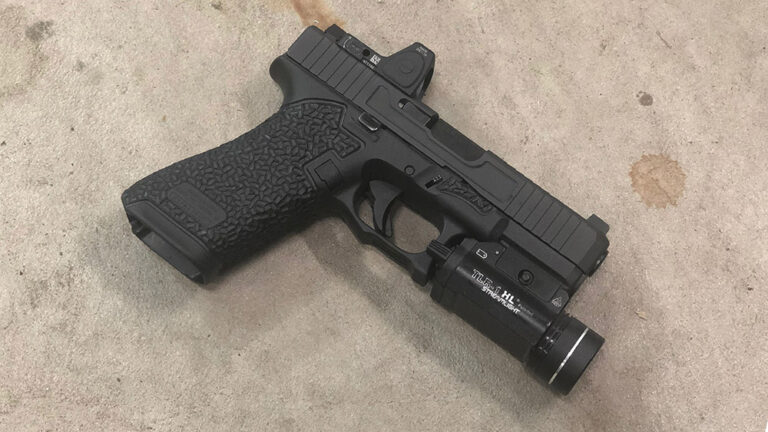SureFire SOCOM-4 Series—A New Fighting Suppressor
Fountain Valley, CA—SureFire, LLC, manufacturer of the world’s finest—and most innovative—illumination tools and…
Fountain Valley, CA—SureFire, LLC, manufacturer of the world’s finest—and most innovative—illumination tools and…
Shinenyx—creators of a cutting-edge fusion of digital night vision and thermal imaging technology—has…
German Precision Optics’ Passion APO is a high-performance compact spotting scope designed and…
The Mod-Navy Qual I’ve been doing this qual (or drill, or whatever the current nom…
• Built for road trips and off-road use• Manual transmission equipped• Wrapped in MultiCam Arctic…
I designed the Button Man to give shooters a low-round-count, low-light-engagement drill that involved both…
There’s an old saying that has been used in firearms for a while- "90% Indian, 10% Arrow." It’s stuck around because it’s a true statement. This week at the range, I got to see the good, the bad, and the ugly when it came to the gambit of shooters. But perhaps one of the keenest observations I made was that the coolest, techiest, newest, most expensive gear did not necessarily make someone a better shooter.
Rewind several years back to when I first began shooting seriously. For years, I had been shooting at rocks in the hills and at the occasional coyote with a less-than-stellar hit rate. But being young and dumb, I thought I was likely the greatest shooter in my state. One day I walked into a local gun shop and within minutes of talking to the owner and one of the guys behind the counter, realized that I had just entered an entirely new dimension of shooting. A few months later, they agreed to take me to the range with them, and train me. I asked that they treat me like an absolute beginner, and I promptly forgot everything I thought I knew, and my firearms journey began in earnest. Within a few more months, I had gotten the chance to train with not only these skilled shooters, but also a cadre of SF, contractors, competitive shooters, and world-class shooting instructors. I’m nobody special, but I was in the right place at the right time with the right people, to get the right training. Soon enough, I was building my very own AR-15 rifle.
Naturally, I wanted to throw in the baddest triggers, brakes, optics, handguards, charging handles, buttons, gadgets, widgets and everything else you can put on an AR-15. That’s half of the fun right there isn’t it? Well, turns out the guys who were training me on an almost-weekly basis had other plans. When I went to build my own AR, they instructed me to only use a factory mil-spec trigger, mostly standard-issue components, and I was, under no uncertain terms, allowed to use a red dot or other modern optic. Yep, I got relegated to the venerable Magpul MBUS backup iron (actually plastic) sights. Once I mastered the fundamentals of sight picture, trigger press, presentation, and ONLY once I had mastered using my basic equipment, was I allowed to upgrade.
Being new to the AR game and wanting to get a cheap and easy-to-use red dot, I bought a cheap Sightmark Ultra Shot QD. And it worked! I ran the living daylights out of that red dot. It held zero through several thousand rounds, and while it may not have been battleproof it was an excellent sight that kept me busy until I upgraded to an EOTech nearly a year later. I gave the Sightmark to my brother, and it still runs today.
So when Sightmark sent me one of their Wolfhound 6×44 HS-223 optics, I was intrigued. After using one for the last few months, I think it’s a viable and excellent offering from Sightmark.

The first thing you notice about the Sightmark Wolfhound 6×44 is that the finish and coating is a sleek mix of black metal housing inside of a rubber skin. It doesn’t feel like the old Sightmark optic I used, with a combination of plastic and flimsier-feeling metal. It feels solid, and the weight (23.5oz)doesn’t feel awkwardly heavy- it feels like you’re holding a well-built, albeit dense, sighting system. Part of the weight comes from the fact that the optic’s rail attachment mount is integrated into the sight. So thankfully, you don’t have to buy a separate mount to put the Wolfhound on your rifle. On the top of the Wolfhound is a removable Picatinny rail. I thought this was a great option to put onto a 6x optic. If you want to throw a mini red dot onto the top of the optic for close range work, or just to have more dots to look at targets with, you can. This option is frequently employed on ACOG optics, and works well.
Included with the Wolfhound is a rubber lens cover and a "Killflash Filter. " The filter is a screw-on accessory that mounts to the front of the sight to reduce glare and, well, kill any lens flash that might be screwing up your sight picture when you’re shooting. Thankfully, Sightmark included a CR2032 battery with the Wolfhound, so you don’t have to dig into your own stash of batteries. Unbox, power up, mount the Wolfhound on your rifle, and you’re ready to go.
Sightmark has put a significant amount of thought into the features of the Wolfhound. It comes in both 6x and 3x magnification, and has an etched glass reticle with an illuminating outer circle. It has 10 levels of brightness- 5 for red illumination, and 5 for green illumination. I suppose it’s a matter of personal preference, but during the day the green illumination is hard to miss. The 6x model has a 2.8-inch eye relief, which is impressive by any standard. Covered windage and elevation adjustment dials adjust with ¼MOA clicks. The reticle is ballistically matched to .223, with holdovers for both 55 and 62 grain projectiles from 300-900 yards.
The HS-223 horseshoe reticle is a great choice for a 6x optic to mount on an AR platform. Designed for both close- and long-range shooting, it has a .5MOA central aiming dot, and a 7.5MOA outer horseshoe hovering just over and around it. Directly below the .5MOA central aiming dot, at the imaginary base of the horseshoe is a second .5MOA aiming dot, providing a 300 yard holdover reference. Below that is a double sided set of subtensions, for holdovers ranging from 400-900 yards. On the left side of the reticle are the 55gr ammunition holdovers, and on the right are the 62gr ammunition holdovers. Both of these sides are marked with small numbers at the bottom 5:00 and 7:00 positions. The width of the individual subtensions corresponds to the shoulder width of the average human. So, by placing your subtensions across the shoulders of your human-sized target (unless of course you are actually using this to fight predators of the two-legged variety), rudimentary rangefinding can be accomplished. The horseshoe, whether illuminated or not, is large and fast. Being that the Wolfhound is a 6x optic, it wasn’t optimal for CQB-type work, but the large ring allowed for rapid target acquisition, and the small and crisp .5MOA central aiming dot was excellent for more precise shot placement.
One of the more important factors in choosing an optic is how much light the objective lens transmits to the shooter’s eye. The Wolfhound is remarkably clear, and the transfer of light is at the higher end of the middle of the pack. It’s no $2500 Kahles or Vortex Gen II, but it beats most of the mid-range options I’ve seen. Personally, having shot some of the finest precision rifle setups in the world, the reticle’s etching seemed rather thick. I prefer thinner, finer subtensions. That said, it really isn’t that bad, and the thicker subtensions are definitely easier to see than the ultra-fine lines on the Kahles K624i I used for competition. For shooting at the range, or for quick target acquisition, the larger subtensions were easy on the eyes and were clearly distinguishable against the backstop. In the manual included with the Wolfhound there a detailed map of the specific MOA holdovers within the reticle. Overall, for a 6x optic with a hint of DMR, it’s a good option.
After playing endlessly with the Wolfhound- aiming at apples and apple bins outside of my house with an empty gun, a day at the range was in order. And through drills and hundreds of rounds and my characteristic Chris Brown-like treatment of the optic, the Sightmark held up. It didn’t lose zero, and functioned like a champ. I tried using the Wolfhound for some close-quarter shooting, and the reticle is fast. However, 6x magnification is too much for me to effectively use it at close range. It turned into a more point-shooting affair, using my non-dominant eye to see the target and my dominant eye to overlay the reticle. When illuminated, this worked fairly well. I had a difficult time doing it without illumination, but I am extremely right-eye dominant.
It was at medium-range distances that the Wolfhound shone. The small .5MOA dot allowed for precise shot placement at 100-150 yards, and cleanly-placed shots out to 300 yards (where the second .5MOA aiming point comes into play). In practice, the reticle’s thickness turned out to be a non-issue. Simply using the top side of the lines worked well. I got lucky that day- the wind was almost nothing. With 6x magnification and a clear holdover, I was able to ring the 500-yard targets for reps, with both 55 and 62 grain bullets. The holdovers were close but not perfect. As with any optic, see where your rounds lie and compare that against the holdovers provided within the reticle. The weight of the optic was noticeable, but didn’t turn out to be as bad as I had expected. As with any day at the range where your equipment works and your new sight sends rounds where you intended, it was a good day.
With the Wolfhound 6x, Sightmark has presented a capable mid-range solution for the AR enthusiast looking to extend his or her practical shooting range. It is a well-built and well-thought out optic, and with an attractive price, I think shooters should not ignore Sightmark’s mid-range offering. And so, as you- the Indian- shoot and train and practice your fundamentals, now your arrow can be a little better too.

Check out Judah Torres on Facebook and Instagram.
* The views and opinions expressed on this web site are solely those of the original authors and contributors. These views and opinions do not necessarily represent those of Guns & Tactics Magazine,
the administrative staff, and/or any/all contributors to this site.
Judah is a firearms instructor and competitive shooter. In addition to writing gear reviews, he covers tactics and mindset for the shooter looking to be ready for anything. When he isn’t shooting, he is a certified personal trainer and an avid outdoors enthusiast.
If you’ve done any appreciable amount of reading about the Vietnam War, you know that one of the grunt’s best friends in the air was the AC-130 Specter…

Tim and Becky Yackley will compete in the 2019 IPSC Rifle World Championship in Sweden, August 3 – 10, competing with their CMMG RESOLUTE rifles.

Blue Force Gear gives us some updates from products released last year and a look at what is new for 2018. Thanks goes out to Blue Force Gear…

For those who believe tea belongs in the harbor, CMMG is pleased to offer Select Fire Coffee. The coffee will be offered as either ground or whole bean.

In this video, we get a close look at the amazing services performed by Danger Close Armament. Bottom line, these guys do the best work in the business.
![M+M Industries Hybrid Rifle M10X [Triggrcon 2022]](https://un12magazine.com/wp-content/uploads/2022/10/MM-Industries-M10X-768x432.jpg)
The M+M Industries M10X. A continuous mono top receiver, AK Mags, Long Stroke piston, AR sector and Cold Hammer Forged Barrel.
© 2025 UN12 Magazine
© 2025 UN12 Magazine
Wait! Don’t forget to